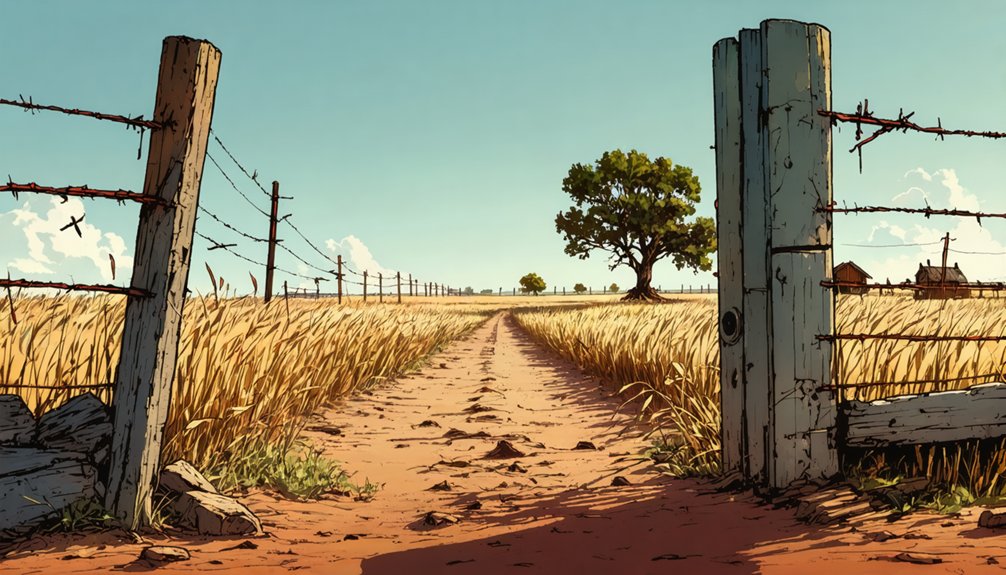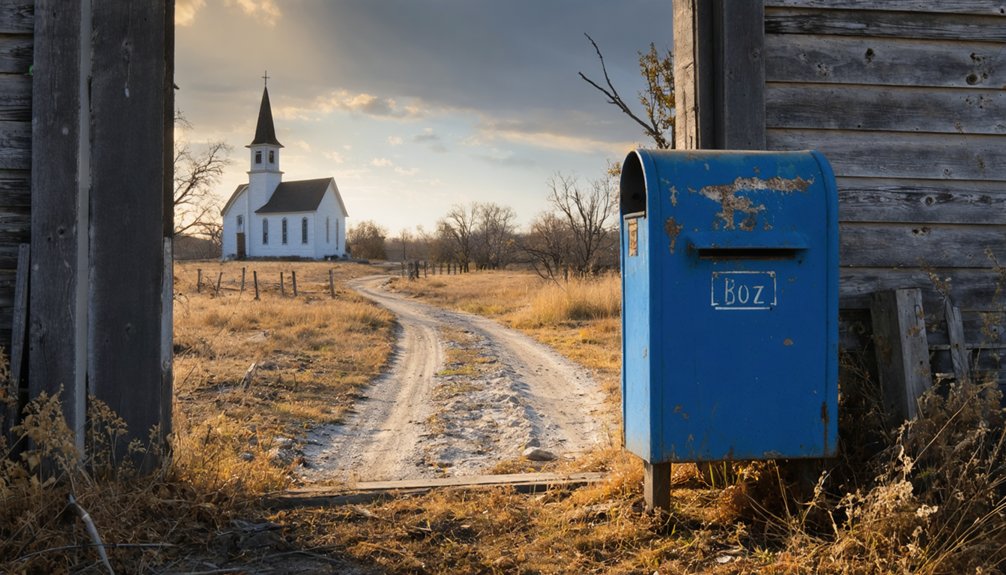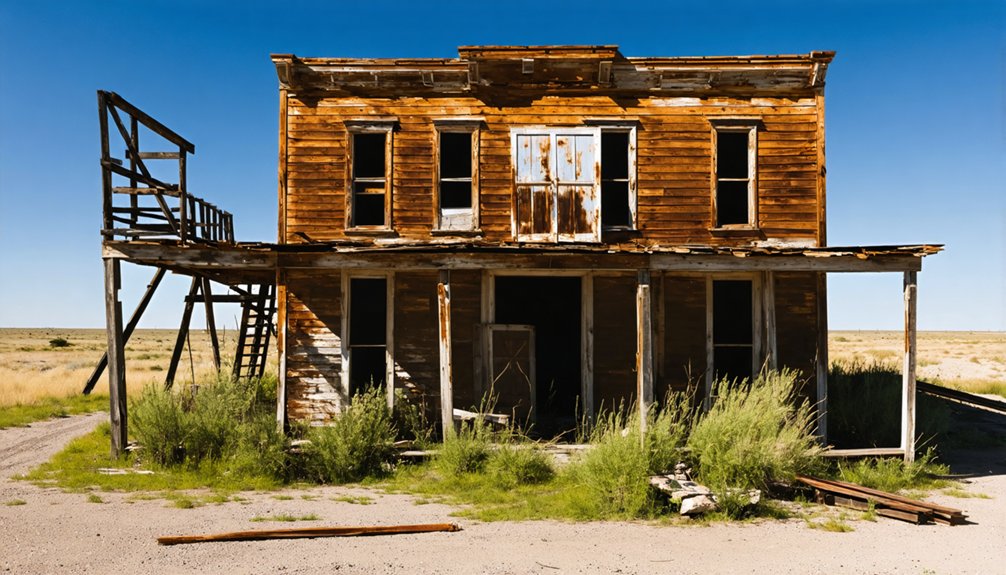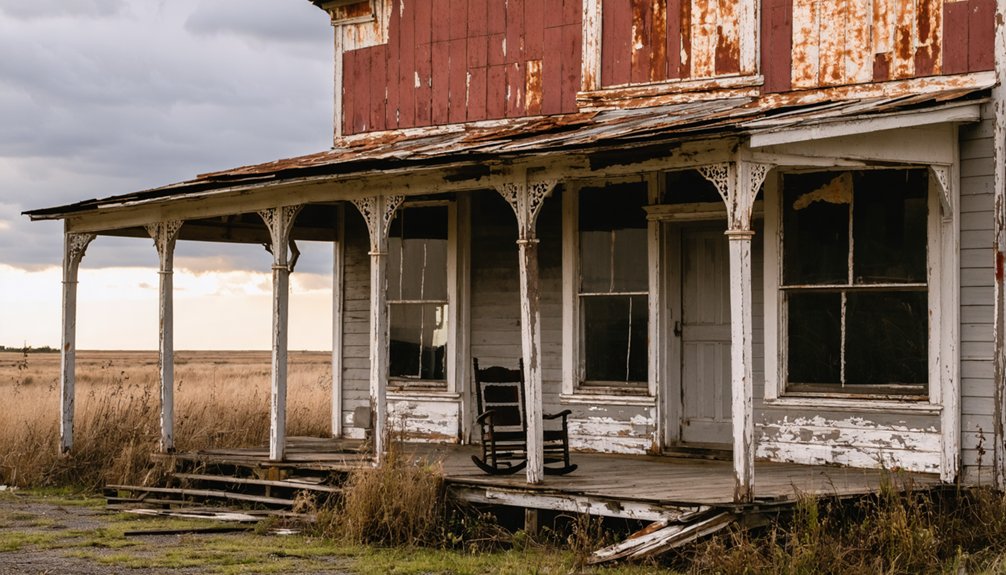You’ll find Boz, Texas, five miles southwest of Waxahachie along Farm Road 1493 in Ellis County. This ghost town emerged as a farming settlement in the late 1880s, anchored by the Brack family’s pioneering leadership and a post office established in 1891. While it once supported 75 residents in the 1930s, Boz declined after its post office closed in 1906. Today, only Bethel Methodist Church and scattered foundations mark this reminder of Texas’s rural heritage.
Key Takeaways
- Boz was a farming community established in the 1880s near Waxahachie, Texas that declined into a ghost town by the late 20th century.
- The post office’s closure in 1906 and school’s shutdown in 1943 marked major turning points in Boz’s decline from 75 residents.
- Population dwindled to just 15 residents by 1986, with most residents relocating to nearby towns for services and opportunities.
- Bethel Methodist Church remains the primary historical structure, while other buildings exist only as scattered foundations along Farm Road 1493.
- The Brack family established Boz’s first permanent settlement in 1850, leading the community’s development before its eventual abandonment.
Origins and First Settlement
While the exact motivations of its earliest settlers remain unclear, Boz emerged as a farming community in southwestern Ellis County during the late 1880s. The settlement patterns centered around prime agricultural land, about five miles southwest of Waxahachie along what’s now Farm Road 1493.
You’ll find that these pioneers chose their location strategically, considering the soil’s suitability for farming practices common to late 19th-century Texas. Like Thurber’s coal workers, many were immigrant farmers seeking opportunity in Texas.
The establishment of a post office in 1891 marked Boz’s formal recognition as a community, serving local farmers until 1906. Early settlers quickly developed the infrastructure needed for an agricultural society, including a church and school. The area once supported a thriving population of seventy-five residents in the mid-1930s.
Boz’s post office establishment in 1891 symbolized more than mail service – it represented the birth of a proper farming community.
This foundation reflected the community’s rural character and the self-sufficient spirit of Texas frontier settlements.
The Brack Family Legacy
E. M. Brack’s 1850 arrival as Boz’s first permanent settler established a pioneering legacy through his extensive family network and land development.
Through his marriage to Lucy P. Sims and his children’s strategic local marriages, the Brack family created lasting social bonds that shaped the Boz-Bethel community’s development. The family held annual reunions at Sycamore Cemetery where they shared important genealogical records.
The family’s agricultural enterprises, including slave-based farming near Greathouse cemetery, laid the economic foundation that sustained Boz’s growth throughout the nineteenth century. Judge Brack’s legacy continued through his four daughters and three sons who remained prominent figures in the community.
Early Settlement Leadership
Leading the early development of Boz, Texas, Judge Ezekiel Brack established himself as the area’s first settler and a pivotal figure in the Greathouse Community. His settlement governance shaped the region’s early infrastructure, building the first house near Greathouse Church and Machett Spring.
Through strategic land acquisitions and community leadership, he helped transform cattle trails into organized spaces that would serve generations. His dedication to public service led him to hold multiple public offices while supporting local development. Like other Perry family settlers of Texas in the late 1870s, his influence helped establish lasting community foundations.
- Built his homestead near a historic Native American water source, demonstrating strategic settlement planning
- Deeded land for community use, including cemetery grounds tied to Greathouse Church Trustees
- Formed alliances through marriage with other founding families, strengthening regional influence
- Established agricultural operations that defined the area’s economic foundation, though significantly through enslaved labor
Marriage and Social Networks
Through strategic marriage alliances, the Brack family established a powerful social network that shaped Boz’s development in the mid-1800s. E.M. Brack’s marriage to Lucy P. Sims connected two pioneering families, while his daughters’ unions with the Dunaways, Whitefields, Perkins, and Pattersons expanded their influence throughout the region. Like many families during this era, they maintained detailed land certificates to document their property holdings.
You’ll find these marriages weren’t just personal choices – they were calculated moves that strengthened social cohesion in the Boz-Bethel area. The Bethel Methodist Church became a central gathering place for these extended families.
The Sims-Brack connection proved particularly significant, as Lucy’s brothers Nicholas and John also migrated from Mississippi to Texas, creating an extensive kinship network.
These family ties supported economic stability through shared resources and labor, while burial patterns at Bethel Cemetery reflect the lasting bonds between these interconnected families.
Agricultural Heritage Foundations
When the Brack family settled in Boz around 1850, they laid the cornerstone of the region’s agricultural heritage. E.M. Brack and his wife Lucy P. Sims Brack established the first permanent homestead, initiating crop cultivation that would shape Ellis County’s economic foundation. Their agricultural venture, supported by slave labor before the Civil War, created pathways for trade and community growth along what would become FM Road 1493. This pioneering family’s efforts helped establish cultural roots that continue to influence the region today. Following common practices of the era, they relied on mule power to operate their cotton gin operations.
- Seven Brack children married into prominent local families, forming powerful agricultural alliances.
- Strategic location near Waxahachie provided crucial market access for farm products.
- Initial farming operations attracted other settlers, transforming frontier land into productive fields.
- Partnerships with Dunaway, Whitefield, and other families consolidated agricultural resources and expertise.
Their legacy of land development and farming practices established Boz as an important agricultural hub within Texas’s expanding frontier economy.
Life in Early Boz
As settlers established themselves in southwestern Ellis County during the late 1880s, Boz emerged as a small but vibrant farming community centered around its church and school.
You’d find early community dynamics revolving around the Bethel Methodist Church and local schoolhouse, where families gathered not just for worship and education, but for social connection in this frontier setting.
The rural lifestyle challenges were evident in the town’s modest infrastructure. You’d see farmers working their land while relying on just a handful of local businesses for essential supplies.
Life in Boz meant working the land with limited resources, as farmers made do with the few local stores available.
The post office, established in 1891, served as a crucial communication link for these pioneering residents. Despite the hardships of agricultural life, Boz’s early inhabitants created a tight-knit community where self-reliance and neighborly support defined daily existence.
Agricultural Foundations

The fertile soil of southwestern Ellis County shaped Boz’s agricultural foundation, where small-scale farming operations dominated the local economy.
You’ll find that local farming practices centered on crop diversity, with cotton, corn, and various vegetables sustaining the community through the late 19th and mid-20th centuries.
Family-owned farms formed the backbone of Boz’s social structure, supporting the local school, church, and small businesses that served agricultural needs.
- Cotton production played a central role, though competition from West Texas eventually challenged local farmers.
- Farm families coordinated activities through church events and community cooperation.
- The region’s water availability supported diversified farming rather than monoculture.
- Farm to Market Road 1493 provided vital access for transporting agricultural goods to market.
Post Office Era and Development
Serving as a significant community anchor from 1891 to 1906, Boz’s post office established the town’s prominence in southwestern Ellis County during its peak development period.
You’ll find that this essential hub fostered community connectivity by enabling local farmers to maintain important communication and commerce links with surrounding areas.
The post office’s importance extended beyond mail service – it attracted settlers, spurred business growth, and solidified Boz’s status as a recognized settlement.
While you wouldn’t have found mail delivery to homes, residents gathered at the postmaster’s location, typically housed in a general store or residence, to collect their correspondence and supplies.
Lacking home delivery, the post office became a vital community gathering spot where locals collected mail and shared news daily.
This arrangement strengthened social bonds until the office’s closure in 1906, which marked the beginning of Boz’s gradual decline toward its eventual ghost town status.
Community Ties and Social Networks

Beyond the post office, Boz’s social fabric was woven through intricate family networks, with the Brack family forming a central thread in the community’s tapestry.
You’ll find that E.M. Brack and his wife Lucy P. Sims Brack established strong kinship connections through their four daughters’ marriages to the Dunaways, Whitefields, Perkins, and Pattersons. These family gatherings and alliances created a robust support system that defined the settlement’s character.
- Community bonds strengthened through shared religious services and burial grounds at Bethel Cemetery
- Extended family networks facilitated cooperative farming and trade
- Social hierarchies reflected the era’s plantation-style structure
- Marriage between local families consolidated economic and social alliances
The settlement’s survival depended heavily on these interconnected relationships, which provided stability and mutual aid in an isolated rural setting.
The Path to Abandonment
You’ll find Boz’s path to abandonment began with the closure of its post office in 1906, marking the first significant loss of essential community services.
The population’s steady decline accelerated after the local school closed in 1943, dropping from seventy-five residents in the 1930s to just fifteen by 1986.
Post Office Closure Impact
The closure of Boz’s post office in 1906 marked a pivotal moment in the town’s decline, triggering a cascade of economic and social consequences that would ultimately lead to its abandonment.
You’ll find that this seemingly simple administrative change devastated community connectivity, as the post office had served as both a crucial communication hub and social gathering point.
The economic decline that followed was swift and severe, with the town’s population dropping to just 75 residents by the mid-1930s.
- The postmaster’s home, which had doubled as the post office, lost its status as a central meeting place
- Local businesses dwindled to just three establishments as mail-dependent commerce became unsustainable
- Farmers and residents were forced to seek postal services in neighboring towns
- The loss of federal presence signaled the beginning of Boz’s transformation into a ghost town
Population Migration Timeline
While Boz initially flourished as a rural settlement in the late 1880s, its population trajectory followed a gradual but steady decline spanning over a century.
You’ll find that the first significant marker of population decline came in 1906 with the closure of the post office, signaling diminishing community resilience.
Though the church remained a social anchor through the early 20th century, economic shifts and the draw of larger towns like Waxahachie steadily pulled residents away.
The most dramatic exodus occurred in the late 20th century, driven by the planned Superconducting Super Collider project.
By 1992, you’d have found just one remaining resident in Boz.
The lack of commercial infrastructure and agricultural decline ultimately led to complete abandonment, transforming this once-vibrant community into a ghost town.
Remnants and Historical Sites

Among the few surviving structures in Boz, Texas, the Bethel Methodist Church stands as the most prominent historical remnant, particularly serving as a filming location for the 1984 movie *Places in the Heart*.
This architectural significance represents one of the last tangible connections to Boz’s cultural heritage, as most original buildings have vanished or fallen into disrepair since the town’s abandonment.
- You’ll find scattered foundations and footings of former schoolhouses and residences throughout the area.
- The post office site (1891-1906) no longer exists physically.
- Farm to Market Road 1493 provides access, though you’ll encounter minimal historical markers.
- The church remains accessible and visible, though the surrounding area has largely reverted to agricultural land.
The 1990s Super Collider project hastened the town’s decline, leaving few preserved structures for modern visitors to explore.
Preserving Boz’s Memory
Since the physical remnants of Boz have largely disappeared, community-driven preservation efforts have become instrumental in keeping the town’s legacy alive. In 1962, local residents formed a preservation group that’s tackled significant preservation challenges, including fragmented land ownership and complex zoning restrictions.
Local residents united in 1962 to preserve Boz’s heritage, confronting complex land ownership and zoning challenges along the way.
You’ll find that community engagement centers on documenting oral histories and maintaining artifacts, while volunteers work to modernize historic structures with utilities to support visitor access.
The town’s preservation initiatives have gained traction through partnerships with regional tourism boards and media exposure on Texas travel programs. Local advocates actively promote educational visits, connecting students with Boz’s heritage through guided tours and exhibits.
Despite lacking formal governance, these grassroots efforts guarantee that Boz’s historical legacy endures for future generations.
Frequently Asked Questions
What Natural Disasters or Events Contributed to Boz’s Eventual Abandonment?
You’ll find that severe drought effects devastated farming and water resources, while flooding impact damaged infrastructure and farmland. These disasters, combined with other economic pressures, drove residents from Boz.
Were There Any Notable Crimes or Lawlessness in Boz’s History?
Unlike nearby Best where shootouts were common, you won’t find documented crime incidents in Boz’s history. Historical records don’t show significant lawlessness or law enforcement challenges in this small settlement.
Did Boz Have a School, and How Many Students Attended?
You’ll find Boz’s schoolhouse operated until 1943, serving local farming families alongside the Methodist church. While student enrollment records aren’t preserved, the town’s population of 75 suggests a small student body.
What Native American Tribes Originally Inhabited the Boz Area?
You’ll find the area’s rich cultural heritage centered around the Comanche, who dominated the region, while Lipan Apache, Caddo, Waco, Tonkawa, and Kiowa tribes also shaped this land’s tribal history.
Did Any Famous Historical Figures Ever Visit or Stay in Boz?
You won’t find evidence of famous visitors in Boz’s history. Given its small population, limited transportation access, and lack of historical significance, prominent figures likely never visited this rural farming community.
References
- https://www.txgenwebcounties.com/ellis/_ghost_towns/Boz_Texas.html
- https://www.allacrosstexas.com/texas-ghost-town.php?city=Boz
- https://pastmaps.com/explore/us/texas/ellis-county/boz/hiking-exploration
- https://www.youtube.com/watch?v=SaUCT73CKnY
- https://texashistory.unt.edu/ark:/67531/metapth61101/
- https://en.wikipedia.org/wiki/List_of_ghost_towns_in_Texas
- https://www.texasescapes.com/TOWNS/Texas-Ghost-Towns-2-Central-Texas.htm
- https://www.texasescapes.com/TexasGhostTowns/BozTexas.htm
- https://dallas.culturemap.com/news/travel/07-31-17-thurber-texas-coal-mine-ghost-town/
- https://txprobatelawyer.net/the-rise-of-ghost-towns-can-you-own-a-piece-of-abandoned-texas/



